Rhonda Watton, Templeton Middle School, Sussex, Wisconsin
DESIGN LEVEL: Middle School
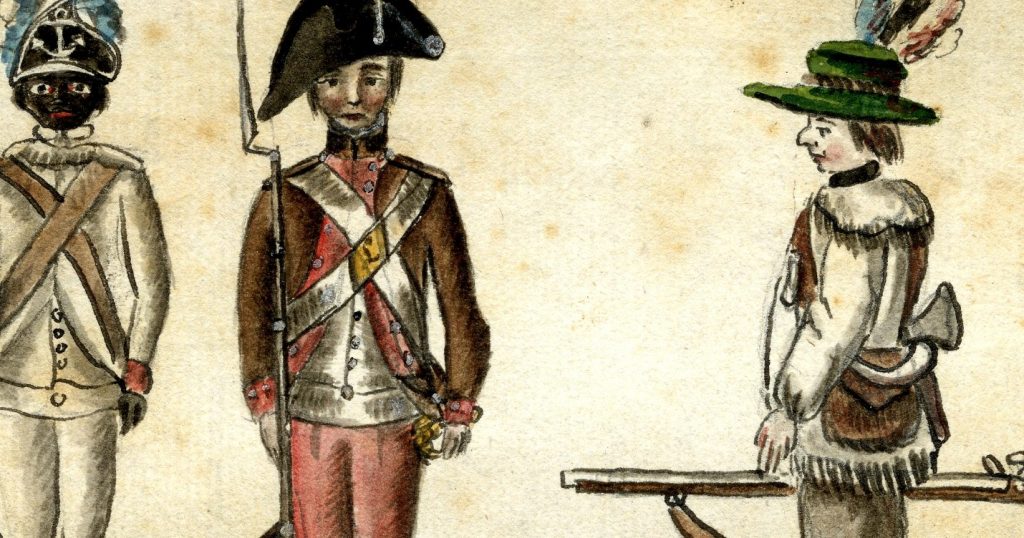
Overview
This lesson invites students to explore the experiences of a Revolutionary War solder, including items used and the challenges they faced.
Objectives
Students will . . .
- Examine objects used during the war.
- Analyze images of soldiers, read primary sources and observe the challenges soldiers faced during the Revolutionary War.
- Discover how soldiers maintained their health in camp.
- Research a soldier and share their experiences during the war.
Materials
- Cartridge box, https://americanrevolutioninstitute.pastperfectonline.com/webobject/D99CE447-9237-4B8D-9751-339231333541.
- Powder horn, https://americanrevolutioninstitute.pastperfectonline.com/webobject/7575DEE2-5323-44FD-8B22-102339880923.
- Canteen, https://americanrevolutioninstitute.pastperfectonline.com/webobject/9F69297E-A52D-4661-9B0A-473945227115.
- Bayonet, https://americanrevolutioninstitute.pastperfectonline.com/webobject/09D94D93-3733-44FE-8E82-635091806503.
- Soldiers in Uniform watercolor by Jean Baptiste Antoine de Verger
- Lunch Bite-The Female Review: or Memoirs of American Young Lady, Rachel Nellis
- Tragedies and Hardships of 18th Century Warfare, video segment, Bill Fowler
- Continental Army Without Critical Supplies video segment, Bill Fowler
- Directions for preserving the health of soldiers : recommended to the consideration of the officers of the Army of the United States, Benjamin Rush, 1778
Recommended Time
One 50-minute class session, along with independent research time and presentation preparation.
Activity
Object Analysis: Divide students into four groups for a jigsaw activity using the thinking routine “See, Think, Wonder” to examine four objects (cartridge box, powder horn, canteen and bayonet) used by Continental soldiers during the Revolutionary War. Ask students to consider what they see, what they think about the object and what they wonder about the object? Students should then share what they learned or thought about each object, and predict the object’s use.
Image Analysis: Students should analyze the Soldiers in Uniform watercolor drawn by a French officer featuring Patriot soldiers equipped with several of the items examined during the object analysis. Have students share whether what they thought about the soldiers equipment was correct. Discuss other parts of the soldier’s uniforms and equipment as time allows.
Video Analysis: Students should watch the video about Deborah Sampson as well as the two videos featuring historian Bill Fowler’s discussion of the hardships of eighteenth-century warfare and the struggle to supply the Continental Army. Students should record or sketchnote some of the struggles faced by Continental soldiers.
Text Analysis: Benjamin Rush, a well-known physician and civic leader, provided a manual detailing how soldiers should remain healthy while in service. Students should read Directions for preserving the health of soldiers : recommended to the consideration of the officers of the Army of the United States and record three ways soldiers could maintain or improve their health.
Assessment
Formative Assessment: Students will take notes on what they learn about the objects, what life on the battlefield was like and what challenges the men faced.
Summative Assessment: Students will research a Revolutionary War Soldier and create a short Flipgrid video sharing that soldier’s experience including the unit in which they served, where they served and what objects that person would have used in camp and battle.
Standards Addressed
WISCONSIN STANDARDS FOR SOCIAL STUDIES (2018)
Standard SS.Hist3: Wisconsin students will connect past events, people, and ideas to the present; use different perspectives to draw conclusions; and suggest current implications.
Standard SS.Hist4: Wisconsin students will evaluate a variety of primary and secondary sources to interpret the historical context, intended audience, purpose, or author’s point of view (Historical Methodology).
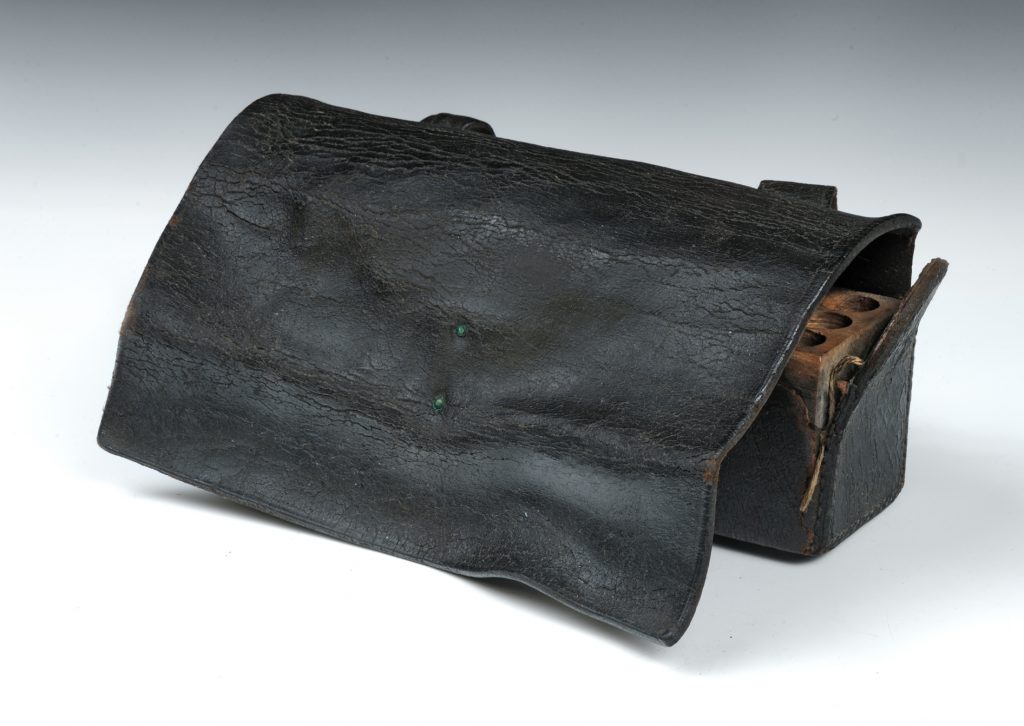
Cartridge box
American
Late 18th-early 19th centuryGift of John Sanderson du Mont, New York State Society of the Cincinnati, 1994
Early American musket cartridge box, late 18th-early 19th century. Rectangular pine cartridge block with 24 holes for .69-caliber musket cartridges set in a leather box and flap with a reconstructed brass catch and clasp. Belt loops are sewn to the back side of the leather box. One early paper cartridge remains in the box.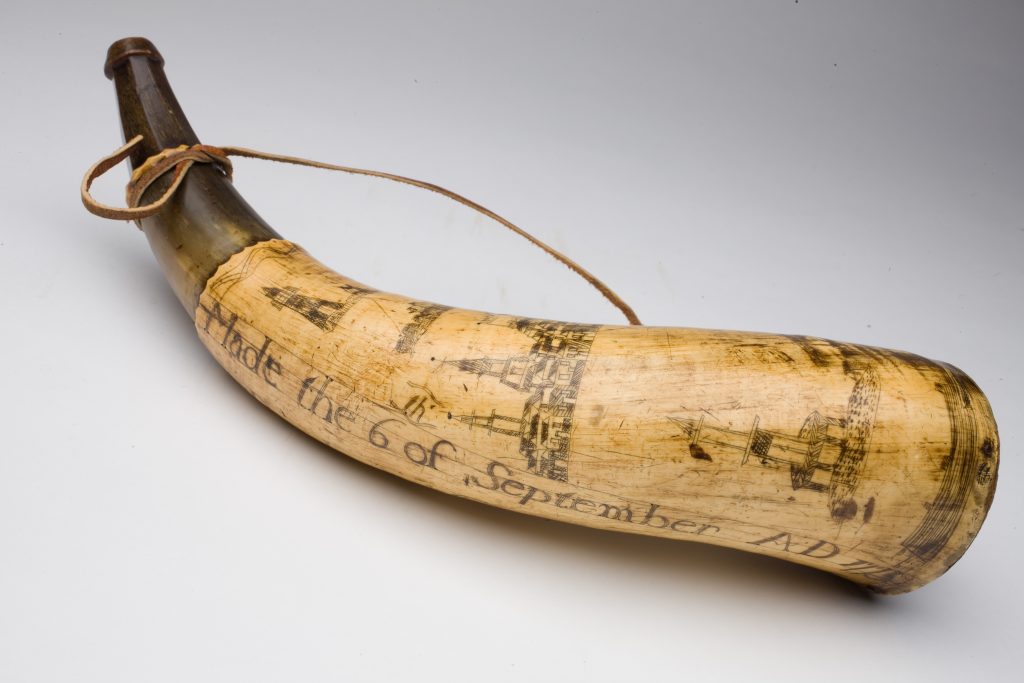
Powder horn
Roxbury, Mass.
1775Gift of John Sanderson du Mont, New York State Society of the Cincinnati, 1994
Engraved powder horn made by an unidentified professional carver for Thomas Kempton (1740-1806) of Massachusetts during the Siege of Boston in 1775. Scenes of Roxbury and Boston are engraved on the horn, including the Boston lighthouse, a fort flying the British flag (likely Castle William on an island in the harbor), Boston Neck, and buildings and barracks in Roxbury, including a meetinghouse. Inscribed in three rows: "Made the 6th of September AD 1775 / at Roxbury Camp for Captain / Thomas Kempton." On one end, the horn has a beveled spout with a fluted carved collar and a pegged plug (plug not present), and on the other end it is capped with a circular piece of wood nailed to the sides of the horn.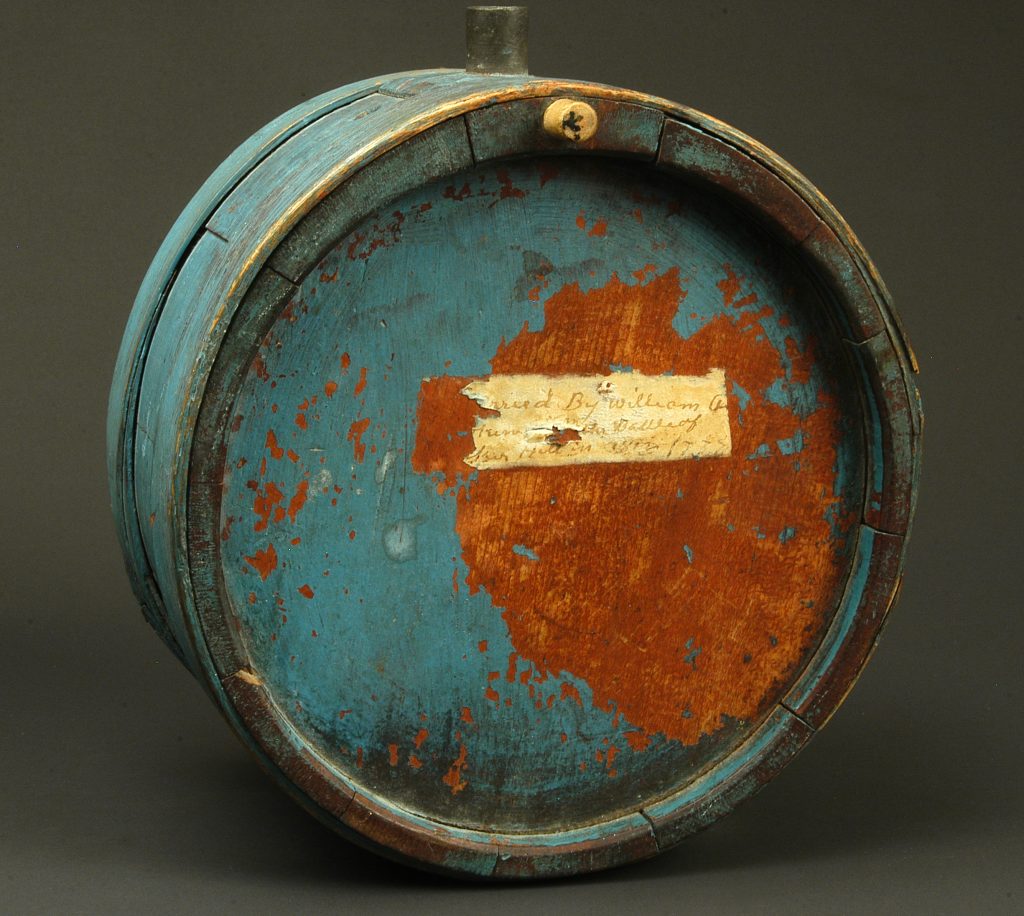
Canteen
American
Late 18th centuryMuseum Acquisitions Fund purchase, 2005
American stave canteen owned by William Adrian Hawkins (1742-1817), an officer in the New Hampshire Continental Line during the Revolutionary War, made in the late 18th century. Drum-style canteen with twelve wooden staves encompassed by two bent hickory straps, one with single fingering. Has an iron spout and nails and two wooden pegs. Painted blue, with areas of red paint visible underneath where the blue paint is missing. A partial paper label pasted on one side reads: "[Ca]rried By William A. / [Haw]kins d[ur]ing the Battle of / [Bun]ker Hill in 1812 1775." The handwritten ink inscription seems to have originally had the date 1812, which was later corrected to 1775 in graphite in a different hand.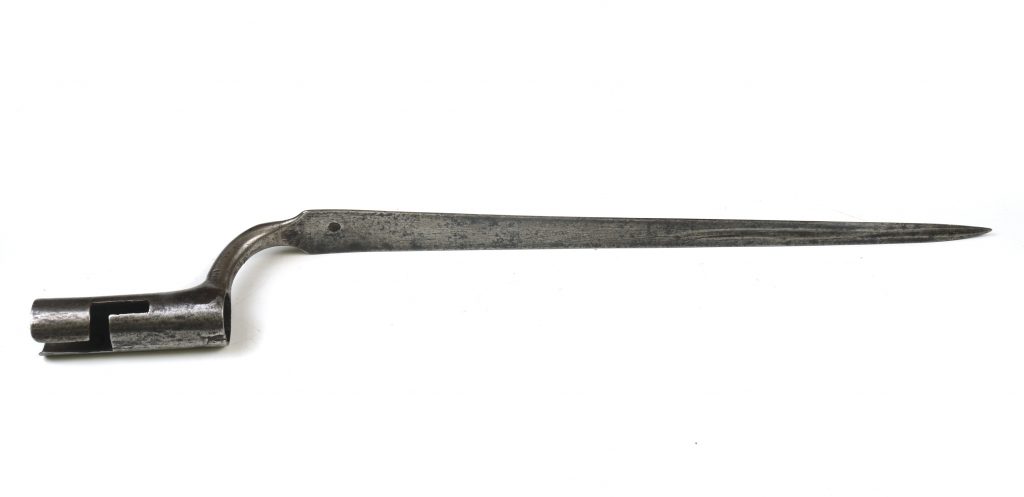
French Model 1766 bayonet
ca. 1766Gift of James L. Kochan, 2017
Socket bayonet for the French Model 1766 infantry musket used during the Revolutionary War. L-shaped notch at socket for fitting onto musket, extends into a curved extension from which the blade protrudes. Triangular blade is flat on the back and at the front shaped from flat at sides, extending into a peak at the center. The blade is widest at the bottom by the curved extension and gradually decreases in width to the pointed end. An unidentified circular mark is stamped on the flat back side of the blade near the curved extension.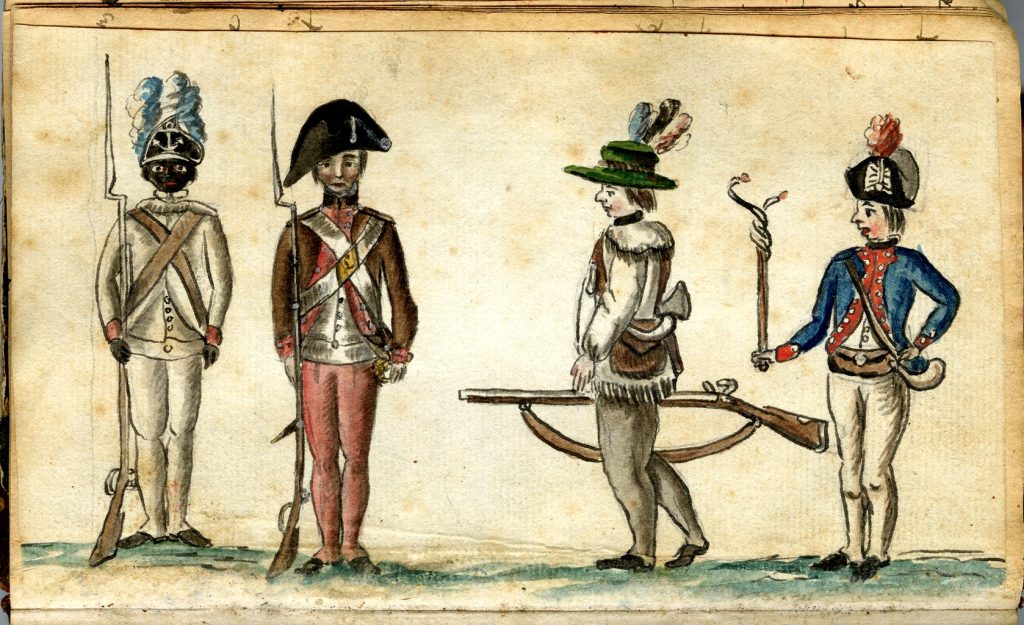
Soldiers in Uniform
Jean Baptiste Antoine de Verger
1781Anne S.K. Brown Military Collection, Brown University
This watercolor was madee by a French officer who served with the combined American and French forces during the Yorktown campaign. Among the four soldiers depicted is an African American member of the First Rhode Island Regiment.
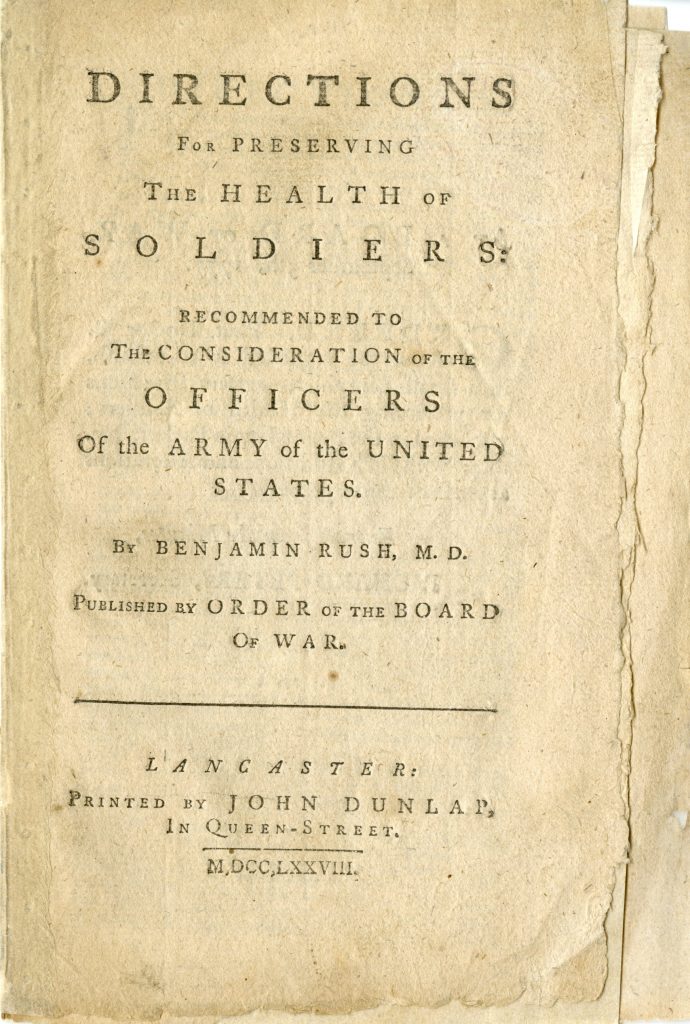
Directions for Preserving the Health of Soldiers: Recommended to the Consideration of the Officers of the Army of the United States
Benjamin Rush
Lancaster, [Pa.]: Printed by John Dunlap, 1778The Robert Charles Lawrence Fergusson Collection
First published in The Pennsylvania Packet in 1777, Dr. Rush’s advice for soldiers was reissued as a pamphlet by order of the Board of War the following year. “Fatal experience has taught the people of America that a great proportion of men have perished with sickness in our armies than have fallen by the sword,” Rush wrote. “The art of preserving the health of a soldier consists of attending to the following particulars: I. DRESS. II. DIET. III. CLEANLINESS. IV. ENCAMPMENTS. And V. EXERCISE.”

